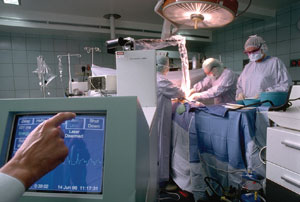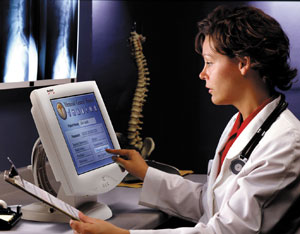When it comes to touch screens, the requirements of doctors and average users can differ. The needs of medical office staff, however, are like those of information technology workers – and typical users – anywhere. The third and final segment of the medical touch screen market is the patients themselves. They may be using a prosthetic or a gloved hand for input, and what information they enter may be confidential. Thus, their touch screens must be built with those factors in mind.
A look at various medical applications reveals some of the system considerations for touch screens. It also shows why certain technologies work, while others don’t.
It is important to understand that one of the key considerations has nothing to do with the touch screen itself. Rather, it involves the screen’s location, which can be in an FDA-regulated product.
“When essential components of medical devices change, you have to resubmit to the FDA and describe what was changed,” pointed out Thomas Richardson, business development manager for global medical at Tyco Electronics’ Elo TouchSystems of Harrisburg, Pa. The company offers a variety of touch technologies for many markets, including medical.

Touch screen systems are also showing up at patient bedsides and in medical devices intended for use at home. Courtesy of Tyco Electronics’ Elo TouchSystems.
Quite understandably, most system manufacturers would like to keep any FDA change notifications to a minimum. Consequently, touch screen product longevity is an important consideration, Richardson noted.
Five- or seven-year product lifetimes are typical in FDA-regulated medical equipment. That’s several times the life span of consumer or office products. It’s also several generations in the fast-paced world of display technology.
According to Geoff Walker, product marketing manager at privately held optical touch screen maker NextWindow of Auckland, New Zealand, a baker’s dozen of transparent touch-on-top-of-a-display technologies are in use or emerging today. Of those, five account for 99 percent of the market, and one – analog resistive touch technology – has more than a 60 percent share. The fastest rates of growth, however, are in other technologies, particularly the emerging ones.
In all of these technologies, various parameters are measured to determine where the screen has been touched. The list includes changes in resistance, capacitance, the absence or presence of light, time delay of a wave, images and sound. The technologies differ in cost, durability, optical performance, power consumption, ability to accept multiple touches at once and other aspects.
The proliferation of approaches is an indication that one size does not fit all, Walker said. “There are 13 different touch technologies, each of which has its pluses and minuses.”
In the clinic
Aside from regulatory considerations, there are a number of other demands on medical touch screens that arise from the application itself. For instance, touch screens in clinical use usually must be cleaned frequently with a disinfectant, something office systems rarely experience.
To handle this, touch screens must be tough enough to take this punishment without losing responsiveness or clarity. The latter is an important point, said Elo’s Richardson. A touch screen is both an input and an output device. With regard to the second, optical performance is key. Thus, high optical transmissivity of the material, both originally and after repeated wipe downs, is critical.

Touch screens are increasingly being used in clinical settings to control medical devices. Because of that, they must undergo disinfectant cleaning. Courtesy of Tyco Electronics’ Elo TouchSystems.
Richardson pointed to Elo’s acoustic pulse recognition technology that was introduced a few years ago as being one that’s proved popular in medical devices. It works by using four piezoelectric transducers mounted on the edge of the screen to locate where contact took place.
One reason for its popularity in medical applications is that it doesn’t require an overlay and instead allows the use of clear glass. A benefit is that glass has 92 percent transmissivity, far better than the 80 or so percent figure for technologies that depend upon an overlay for touch recognition.
Another advantage is that clear glass can be wiped down repeatedly without damage. Moreover, with the right implementation, cleanup can cover the entire screen out to the very edge. Elo has products that allow this, Richardson said. “That’s a design that we developed, a zero-bezel design, with medical in mind.”
The technology does not currently allow multitouch, a technique that involves using two or more fingers at one time. It’s useful when zooming, panning or flicking through an array of images or moving through a large database. However, Richardson said multitouch capability is under development.
The big view
There’s another consideration for medical touch screens. In some settings, such as an operating room, the size of the screen and the viewing angle are important. As in other collaborative environments, the screen must be big enough for everyone to see what’s on it.
NextWindow’s technology is found in desktop monitors and large displays but in few medical applications. The technology is optics-based, with infrared sources and multiple line-scan cameras that perform detection. The surface is scanned using retroreflectors to supply backlight, and touch location is determined by triangulation from line-scan camera data.
Using large-format touch screens in radiology and other diagnostic applications presents some challenges, said NextWindow’s Walker. “You need a really high resolution display, with lots and lots of very small pixels to properly show the fine gradation of shade that might indicate a tumor.”
Hence, the touch screen technology shouldn’t degrade the quality of the image. Also, while it may not be necessary to disinfect such screens, they will have to be cleaned so that fingerprints and other smudges don’t obscure details.
Currently, according to Walker, touch screens don’t have much of a presence in the diagnostic arena. That may change, however, in part because multitouch is becoming more widely available.
Keeping in touch with patients
Many medical touch screen applications don’t involve doctors at all; instead, they revolve around patients. These could be in kiosks that provide information or in terminals where incoming patient data is entered. For the latter, maintaining patient privacy is paramount.
Other touch screen applications involve medical devices intended for patient use. An example might be blood glucose meters. These use touch because it can provide a simpler and more intuitive user interaction. Touch also can eliminate mechanical parts and allow one hardware version to be built for a global market. The latter is possible because what’s on the screen is changed to display information in the local language.
These patient-centric applications can have some high performance standards, said Dave Henry, marketing manager at 3M Touch Systems of Methuen, Mass. The company makes a wide variety of touch screens. Most use surface-capacitive technology. Also offered by 3M are products based on the detection of bending waves, dubbed dispersive signal technology.

Today, touch screens are used for working with medical records, but they may eventually be used for image manipulation, especially when multitouch capability becomes more widely available. Courtesy of 3M Touch Systems.
Henry noted that, in one application, 3M was asked to make a touch screen that responded only to the touch of a specific stylus. The company did so, using firmware to distinguish between a finger or other body part and a pen tethered to a medical device.
There was a good reason for this request, one that illustrates some of the demands medical touch screens must meet. This case also shows why these applications differ from those in an office setting. In this instance, the reason had to do with patient safety during the programming of a heart pacemaker, Henry explained.
“They actually lock out the finger input and only use our tethered pen, so that avoids any accidental touch of the screen. You can’t bang it with your elbow. So they clearly had a requirement there, which was kind of strange for a touch screen, that it wouldn’t be activated by a finger or a stylus.”